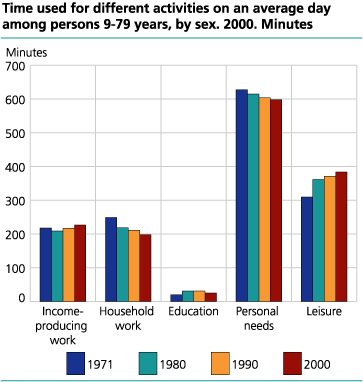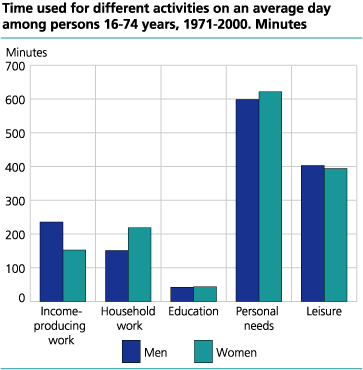Content
Published:
This is an archived release.
More time for leisure activities
We use considerably less time for household work and more time for leisure activities now than before. The average time we use for personal needs, like night sleep and meals, has also gone somewhat down the last 30 years. There has only been a slight change in the time use for income producing work and education.
This development has been fairly even between all the time use surveys that Statistics Norway has carried out in 1971, 1980, 1990 and 2000. These surveys show numbers for an average day, based on all days during a whole year.
6 ½ hours for leisure activities
The population aged 9-79 years in average uses slightly below 10 ½ hours for personal needs per day, including weekends and holidays. We use about 6 ½ hours for leisure activities, about 3 ½ hours at income producing work, slightly below 4 hours for household work and ¾ hour for education. The days we are at work we use on the average slightly above 8 hours for this. When we use time for education, we use slightly below 6 hours for this per day.
More women and fewer men are in income-producing work
From 1971 to 2000 there has been a fairly steady increase in the percentage of women who do income-producing work per day. Among men there has been a different development, but there are still more men than women who use time at income-producing work. 40 percent of the women and 53 percent of the men use time at income-producing work on an average day. Working time has increased most in the age group 16-24 years, but persons at the age of 25-44 years spend most time at work. There has been a considerable and even decline in income-producing work among old people, especially among men. 5 percent of the children 9-15 years use time for income-producing work per day.
Considerable decline in household work among women
The time women use for household work per day has declined by about 2 hours between 1971 and 2000. Among men the average time for household work has increased by about half an hour in this period, which mainly is caused by more men taking part in this kind of work than before. In total the time we use for household work has had a considerable decline in the last 30 years. The percentage that takes part in household work has increased among men in all age groups. It is still women who do most of the household work.
The time for housework halved
Housework, like food preparation, dishwashing and cleaning, is halved between 1971 and 2000 among those who do such work per day. Housework has declined considerably among both working and non-working women. Still women do most of almost all kinds of housework. Also among the children girls do housework to a larger degree than boys.
More men prepare food
More people take part in food preparation in 2000 than before. The reason for this is that men to a lager degree take part in this kind of housework. In all age groups more people prepare food than before, but the time we use preparing food has declined. Fewer women do the dishes and clean the house per day in 2000 than before. In addition, those who do these kinds of work on an average day, use a bit less time than before.
More people go shopping
Between 1980 and 2000, there has been a considerable growth in the percentage who use time to go shopping per day. This applies to both sexes, but especially for men. More people go shopping on weekdays and in the weekends, but Sunday is still mostly a shopping free day.
Less time for meals
We use a little less time for meals in 2000 than in 1971. This decline applies to all age groups and both sexes. Persons at the age of 16-24 years use least time for meals. We use more time for meals in the weekends than on weekdays.
The time we use for night sleep has changed pretty little from 1971 to 2000. Couples with children are those who get least sleep per night, while children are those who sleep the most.
Increased time for leisure among both sexes
The time used for leisure activities has been increasing for both sexes in the last 30 years. The increase applies to all age groups. The leisure of non-working women has increased more than for both working women and working and non-working men. The time for leisure activities has increased on all days except on Sundays. Persons in age group 25-44 years have least time for leisure activities. In return they have longest working hours.
Less time for socializing
From 1990 to 2000 there has been a certain decline in the time used for socializing per day. We use less time visiting each other. This applies to all age groups. More women than men take part in socializing. While older women have most visiting contact with relatives, young people of both sexes have most visiting contact with friends. Young women use most time for conversations per day.
Fewer read
During the last 30 years the percentage who read printed publications per day has declined. Especially fewer men read, young men in particular. Fewer people read newspapers. Particularly there has been a considerable decline in newspaper reading among the young ones. Older men are the most newspaper reading group.
More television viewing
Both the percentage who view television per day and the time used for television viewing have had a fairly even increase from 1971 to 2000. Both sexes view more television, and there is an increase in all age groups. We find most television viewers in the age groups 67-74 years and 9-15 years, i.e. the highest and the lowest age groups. In contradiction to television viewing radio listening has declined through the years. Both the percentage that listens to radio per day and the time used for radio listening increases with increasing age.
Tables:
- Table 1 Time use for different activities among persons 16-74 years. Time use in hours and minutes among all, percentage who has done the activities and time use among those who have done the activities an average day. 1971-2000
- Table 2 Time use for different activities among persons 16-74 years, by sex. Time use in hours and minutes among all, percentage who has done the activities and time use among those who have done the activities an average day. 1971-2000
- Table 3 Time use for different activities among persons 16-24 years, by sex. Time use in hours and minutes among all, percentage who has done the activities and time use among those who have done the activities an average day. 1971-2000
- Table 4 Time use for different activities among persons 25-44 years, by sex. Time use in hours and minutes among all, percentage who has done the activities and time use among those who have done the activities an average day. 1971-2000
- Table 5 Time use for different activities among persons 45-66 years, by sex. Time use in hours and minutes among all, percentage who has done the activities and time use among those who have done the activities an average day. 1971-2000
- Table 6 Time use for different activities among persons 67-74 years, by sex. Time use in hours and minutes among all, percentage who has done the activities and time use among those who have done the activities an average day. 1971-2000
- Table 7 Time use for different activities among persons 16-74 years, by week day. Time use in hours and minutes among all, percentage who has done the activities and time use among those who have done the activities an average day. 1971-2000
- Table 8 Time use for different activities among persons 9-15 years, all and by sex. Time use in hours and minutes among all, percentage who has done the activities and time use among those who have done the activities an average day. 2000
- Table 9 Time use for different household activities among persons 16-74 years, all and by sex. Time use in hours and minutes among all, percentage who has done the activities and time use among those who have done the activities an average day. 1980-2000
- Table 10 Time use for different leisure activities among persons 16-74 years, all and by sex. Time use in hours and minutes among all, percentage who has done the activities and time use among those who have done the activities an average day. 1980-2000 (Corrected 22.05.2002)
Contact
-
Kristin Egge-Hoveid
E-mail: kristin.egge-hoveid@ssb.no
tel.: (+47) 21 09 47 14
-
Elisabeth Rønning
E-mail: elisabeth.ronning@ssb.no
tel.: (+47) 90 76 39 28


